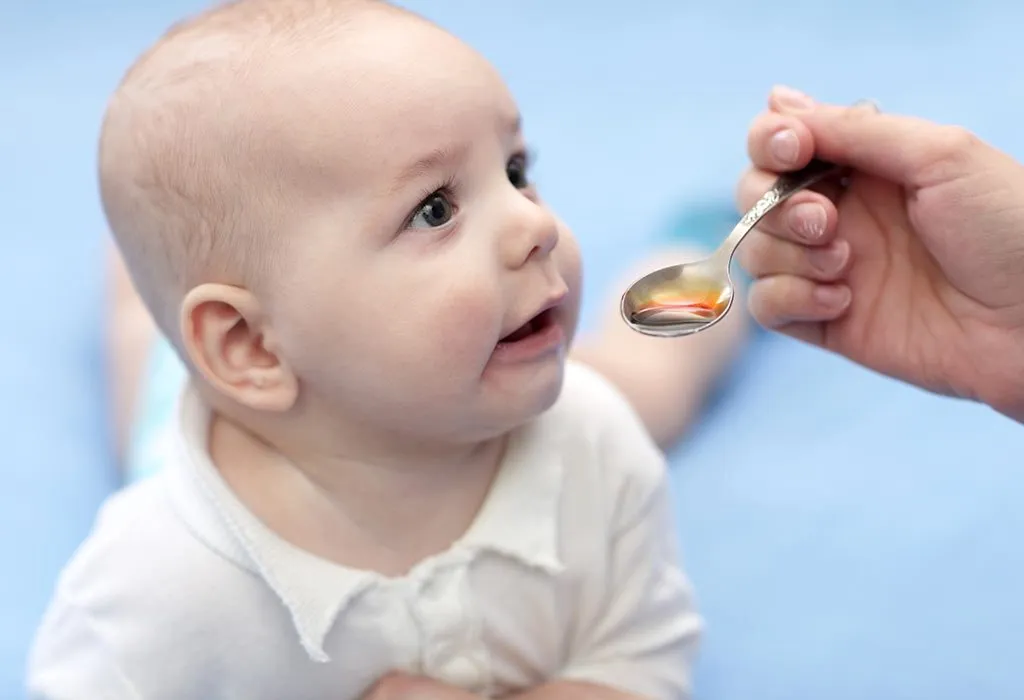How to Get a Baby to Take Medicine

When your baby falls ill and gets cranky, your parenting skills might take a hit as well. All those tricks you learnt to give him food he didn’t like or even medicines might not necessarily work. The constant crying may make you stressed, but you’d also know that your little one is not feeling well and would like him to get better as soon as possible. Babies might spit out the medicine or even puke, and that makes you wonder how to give your baby medicine without him vomiting. Maintaining a calm and composed state of mind can help you see the right way to do it.
In this article, we will tell you how to give medicine to a baby who refuses and share some helpful tips to make the process easier.
Clever Ways to Give Medicine to Your Infant
Some of the best ways to give infant medicine are given below to help make the process easier and stress-free:
1. Following Instructions Properly
- Before administering any medication, it is important to know what exactly you are giving your baby.
- When your doctor prescribes any particular medication, he might advise you to look out for certain points or a certain administering style. Keep those in mind and take notes on the dosage frequencies so that you are well informed and don’t get confused while giving the medicine.
- The medication that is given depends on various factors, such as your baby’s current condition, the ingredients of the medicine and their usual effects, whether it is in the form of pills, syrup, or drops, and the dosage amounts and frequency for each one.
- Medicines are chemicals, after all, and there might be certain side effects of those. Talk to your doctor about them, and watch for any side effects that could get serious. If so, request your doctor for an alternative if there is any.
- After the medicine has been given, it is necessary to store the pills and syrups properly. This is to ensure that the baby or any other person does not accidentally gain access to them and consume them. Also, some medicines change their composition if exposed to heat or light. Make sure these are stored properly in a box located in a cool and dry place.
- When storing them, it is necessary to keep them in the same container that you purchased them in. Refrain from popping out the tablets beforehand and storing them in a box or pouring out the syrup into a different bottle. The storage material could react with the medication, too, or someone might think that the bottle houses something else altogether (5).
- Administering medicine in the right manner is necessary, too. Most syrups come with a measuring cup with the appropriate markings on it. Refer to your doctor’s prescriptions and measure the exact quantity of medicine to give your child. Do not use a spoon or any other utensil to give it. For drops, it is best to use the dropper that comes with the medicine. Otherwise, purchase a separate dropper that is sterile and use it only for that medicine. Do not use the same dropper for different syrups (4).
- Clean methods of administering medicine must be accompanied by clean hands. You will have to hold your baby or clean up any excess medicine when giving it to your child, and your hands need to be hygienic. Unclean hands could add more germs to your baby, rendering the medicine useless.
2. Giving Oral Medications to Baby
- Oral medication manufactured for babies is usually in the form of syrups, which facilitates easy consumption. Before taking the prescribed dosage, close the bottle tightly and shake it well. It’s very rare that medicines do not need to be shaken, so it is necessary to check out the instructions mentioned on the bottle’s packaging.
- Since the medicine’s dosage quantity needs to be precise, most syrups come with a measuring cup or a small mouth that facilitates the insertion of a syringe. Tiny syringes with volume markings are available in the market (8).
- Push the plunger fully before inserting the syringe into the bottle. Hold the bottle upside down. Then, draw out the plunger until the medicine reaches the mark of your required dosage. If the mouth of the bottle is wide open, you can simply dip the syringe as is without the need to tilt the bottle.
- While giving oral medicine, your baby needs to feel safe and have his guard down. Hold him using your elbow so that he is comfortably secure. Tilt your elbow a little higher so his head is above his feet, giving him an incline. If your baby is not in the right mood, wrap him in a blanket or a cloth and soothe him for a little while before giving the medication. If the problem persists, get someone’s help holding the baby or giving him the medicine.
- Positioning the syringe is also important. Insert the tip into the baby’s mouth and aim it towards one of the cheeks and the lower gums. This will allow the medicine to enter the mouth easily and help the baby swallow it. Do not aim the syringe directly towards your baby’s throat, as that could cause him to gag or throw up.
- When depressing the plunger, press it down in small steps. Do not push the entire medicine down since it can be too much for your child at times. Press a little and let your baby swallow it. Then repeat (3). There is no need to pull out the syringe every time since your baby will usually open his mouth to swallow the medicine.
- Certain medicines need to be taken after food or on an empty stomach. In such cases, do not give your baby anything to eat just to remove the taste of the medicine. If it is before food, then the taste can be easily washed out by giving him nice food.
- If your baby spits out a little medicine, you might feel like replenishing that quantity again. Most doctors do not advise a repeat dose in such cases. Also, if the taste of the medicine is too bad, you could opt for a flavoured alternative. There are some pharmacists who are licensed to tweak medication with an added flavour to facilitate consumption (9).
3. Giving Ear Drops to Infants
- In case of ear infections or other illnesses that cause the ear to hurt, administering ear drops is the best way to alleviate those troubles. These ear-drop bottles come with a dropper. If not, you can use a syringe as well.
- Shake the bottle before administering it using your hands. Clean your hands properly for this. The shaking is recommended with hands because it helps the solution reach room temperature, which does not disturb much when it enters the ear.
- Snuggle the baby in a cloth and lay him down so his ear faces you. Hum to him or keep him engaged so that he keeps looking in the same direction. You can hold him still if needed, too.
- To see the ear canal better, gently pull the earlobe in the outside direction. Once the canal is visible, place the dropper tip or the syringe directly over the opening. Hold it as close as possible to the ear without touching it.
- Ear medication dosage is usually prescribed in terms of the number of drops. Press the dropper or plunger to drop the exact amount. Try to be fast with this since your baby will start wriggling when the medicine touches his ear. Hold him if necessary until you finish the entire dose.
- Let your baby stay in the same position so the medicine can trickle down into the canal and be absorbed. Soothe your baby so that he calms down. If the medicine needs to be given in the other ear, wait a little while before changing the baby’s position and repeating the process.
4. Application of Eye Drops or Ointments
- Using eye drops or ointments can be quite challenging and requires deft hands. Most eye drop bottles are squeezable with a built-in nozzle that only puts out drops. If not, you will have to use a separate dropper. Shake the bottle well and wash your hands.
- When administering this medicine, it is best to hold your little one close to you. This makes him feel safe and secure, and holding him in your elbow will allow you to adjust him as needed.
- Now, pull down the lower eyelid of one eye as gently as possible. This will create a tiny pocket where the medicine should go.
- In the case of eye drops, aim the dropper over that area and squeeze out a single drop, letting go of the eyelid. Your baby will blink multiple times, and a little medicine might come out. That’s completely fine.
- If you’re using eye ointment, hold down the eyelid and squeeze a little quantity into the pocket. Let go of the lid, and your baby will blink and spread it properly. Make sure the nozzle does not touch the eyelid.
- Keep a clean cloth handy to wipe the tears or excess medicine that flows out. Let your baby calm down and start opening his eyes and looking around normally again before proceeding to the next eye.
- If this approach becomes difficult at times, you can let your child close his eye and drop the medicine at the corner of the eye closer to the bridge of the nose. The medicine can then seep under the eyelid and reach the eye. Before doing so, confirm with your doctor if you can opt for this approach.
5. Insertion of Rectal Suppository
- Certain medicines need to be inserted via the baby’s rectum. Wear medical gloves so the process stays clean and you don’t end up hurting your baby with your nails.
- Rub the suppository in your hands and use lubricating jelly to warm it. Do not use petroleum jelly for lubrication.
- Place your baby on a surface that he is used to and lift his legs while separating his butt cheeks. Once you see his anus, gently push the suppository inside. It doesn’t have to go completely deep inside.
- Hold your baby’s butt cheeks together for a few minutes while you hum to your baby and distract him from the sensation. Don’t forget to put the diaper again.
Safety Tips While Giving Medicine to a Baby
Giving medicine to babies requires extra care to ensure their safety and well-being. Here are some safety tips on how to give baby medicine:
- Always follow the doctor’s dosage instructions and never give medication without professional guidance.
- Measure the exact amount of medicine with the provided syringe or cup to avoid overdosing.
- Ensure the medicine is age-appropriate and double-check for any allergens or harmful ingredients (7).
- Never give over-the-counter cough or cold medicines to children under 6 years of age (6).
- Always hold your baby in an upright position to reduce the risk of choking.
- Give the medicine slowly, allowing your baby time to swallow safely (1).
- Don’t mix the medicine with their favourite foods or drinks; this can cause them to reject those items later (3).
- Be on the lookout for any side effects or allergic reactions, and seek medical help if necessary.
- Keep medication in a safe place out of the reach of children and ensure it’s stored at the correct temperature (4).
When to Call a Doctor?
While many mild symptoms are normal, certain signs should not be ignored. If you notice any of the following, it’s important to reach out to your paediatrician immediately (6):
- Persistent vomiting or diarrhoea after taking medicine.
- Allergic reactions, such as difficulty breathing.
- High fever that worsens after medication.
- Refusal to eat or drink for a long period.
- Severe drowsiness after medication.
- Unusual irritability or crying that doesn’t stop.
- Trouble breathing or signs of choking during or after administration.
FAQs
1. Is it safe to crush or split the medication?
Some medications can be crushed or split, but not all. Always check with your doctor before altering the form of any medication, as this can affect its effectiveness or cause harm (2).
2. How can I make the medicine taste better?
You can follow the medication with a quick sip of something sweet (if allowed) or a pacifier dipped in a small amount of sugar water to change the taste.
3. How can I keep my baby calm during medication time?
To keep your baby calm, try creating a soothing environment by speaking softly and offering comfort items like a favourite toy or blanket.
Medicating a little baby is difficult but not rocket science. Many people think of giving babies medicine while they sleep, but that might not always be a great idea. Using specific techniques to calm your baby down and being patient with him and yourself can help you gain the skill to administer medication quickly and return to playing with your toddler.
References/Resources:
1. Weinstock. J; 6 Tips That Will Take the Strain Out of Giving Your Child Medication; Children’s Hospital Los Angeles; https://www.chla.org/blog/advice-experts/6-tips-will-take-strain-out-giving-your-child-medication
2. Gill. D, Spain. M, Edlund. B. J; Crushing or splitting medications: unrecognized hazards; PubMed; https://pubmed.ncbi.nlm.nih.gov/22224840/
3. Medicine: How to Give by Mouth; Nationwide Children’s Hospital; https://www.nationwidechildrens.org/family-resources-education/health-wellness-and-safety-resources/helping-hands/medicine-how-to-give-by-mouth
4. Medication Safety Tips for Families; American Academy of Pediatrics; https://www.healthychildren.org/English/safety-prevention/at-home/medication-safety/Pages/Medication-Safety-Tips.aspx
5. How to Safely Store and Dispose of Medicines; Nemours KidsHealth; https://kidshealth.org/en/parents/store-dispose-medicines.html
6. Medicines: Using Them Safely; Nemours KidsHealth; https://kidshealth.org/en/parents/medication-safety.html
7. MEDICATION SAFETY TIPS; SAFE KIDS WORLDWIDE; https://www.safekids.org/tip/medication-safety-tips
8. How to Use Liquid Medicines for Children; American Academy of Pediatrics; https://www.healthychildren.org/English/safety-prevention/at-home/medication-safety/Pages/Using-Liquid-Medicines.aspx
9. Children and Medicine; ConsumerMedSafety.org; https://www.consumermedsafety.org/safety-tips/children-and-medicine
Also Read:
Saline Nasal Drops for Babies
Are Teething Tablets Safe for Babies?
Nebulization for Babies and Kids
Antibiotics for Babies – Are They Safe?
Oral Rehydration Solution (ORS) for Babies
Was This Article Helpful?
Parenting is a huge responsibility, for you as a caregiver, but also for us as a parenting content platform. We understand that and take our responsibility of creating credible content seriously. FirstCry Parenting articles are written and published only after extensive research using factually sound references to deliver quality content that is accurate, validated by experts, and completely reliable. To understand how we go about creating content that is credible, read our editorial policy here.
























